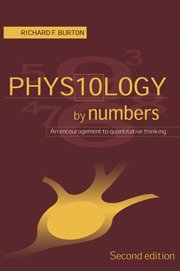Book contents
- Frontmatter
- Contents
- Preface to the second edition
- Preface to the first edition
- How to use this book
- 1 Introduction to physiological calculation: approximation and units
- 2 Quantifying the body: interrelationships amongst ‘representative’ or ‘textbook’ quantities
- 3 Energy and metabolism
- 4 The cardiovascular system
- 5 Respiration
- 6 Renal function
- 7 Body fluids
- 8 Acid–base balance
- 9 Nerve and muscle
- Appendix A Some useful quantities
- Appendix B Exponents and logarithms
- References
- Notes and Answers
- Index
8 - Acid–base balance
Published online by Cambridge University Press: 06 July 2010
- Frontmatter
- Contents
- Preface to the second edition
- Preface to the first edition
- How to use this book
- 1 Introduction to physiological calculation: approximation and units
- 2 Quantifying the body: interrelationships amongst ‘representative’ or ‘textbook’ quantities
- 3 Energy and metabolism
- 4 The cardiovascular system
- 5 Respiration
- 6 Renal function
- 7 Body fluids
- 8 Acid–base balance
- 9 Nerve and muscle
- Appendix A Some useful quantities
- Appendix B Exponents and logarithms
- References
- Notes and Answers
- Index
Summary
The most important quantitative relationships in acid–base physiology relate to (1) the definition of pH, (2) the Henderson–Hasselbalch equation (which may also include the relationship between tension and concentration of dissolved carbon dioxide), and (3) the principle of electroneutrality which has already been treated in Chapter 7. It is assumed that these are all to some extent familiar, but the essentials of (1) and (2), and of the subject of buffering, are re-stated here in the knowledge that acid–base balance is a blind spot for many physiologists. As usual, the hope has been to put a new slant on the subject and at the same time provide opportunites for the exercise of familiar concepts and quantities.
The original meaning of ‘acid–base balance’ is hard to trace, but the term is particularly apt nowadays, since it neatly encompasses three distinct aspects of the topic. The pH of a fluid matters because it governs the ionization of enzymes and other molecules within, or bathed by, the fluid, that is to say the balance of the acid and base forms of imidazole and amino groups especially (i.e. − NH+ and − N in the reaction − NH+ = − N + H+). The pH is controlled in turn by the balance of a particular acid (i.e. carbonic acid, usually treated in terms of carbon dioxide) and its conjugate base (bicarbonate).
- Type
- Chapter
- Information
- Physiology by NumbersAn Encouragement to Quantitative Thinking, pp. 159 - 184Publisher: Cambridge University PressPrint publication year: 2000



